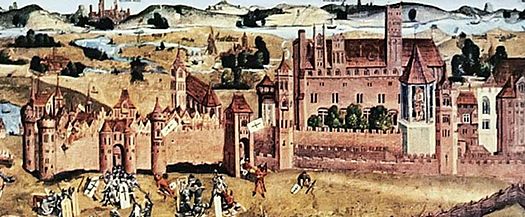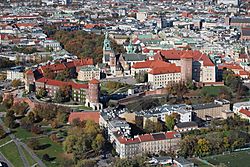Jagiellonian dynasty facts for kids
| Jagiellons |
|||
|---|---|---|---|
Quick facts for kids 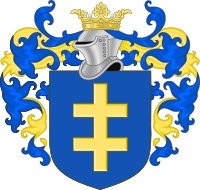 |
|||
| Country: | |||
| Parent House: | Gediminids | ||
| Titles: |
|
||
| Founder: | Władysław II Jagiełło | ||
| Final Ruler: | Anna Jagiellon of Poland | ||
| Founding Year: | 1386 | ||
| Dissolution: | 1596 | ||
The Jagiellonian dynasty was a powerful royal family in Europe. They ruled several countries between the 14th and 16th centuries. These included the Kingdom of Poland, the Grand Duchy of Lithuania, the Kingdom of Hungary, and the Kingdom of Bohemia.
The dynasty began when Jogaila, the Grand Duke of Lithuania, became Christian in 1386. He then married Jadwiga, the Queen of Poland. This made him King of Poland as Władysław II Jagiełło. His family then became a royal dynasty.
The Jagiellons created a strong connection between Poland and Lithuania. This led to the formation of the Polish–Lithuanian Commonwealth in 1569. This period is often called the "Polish Golden Age." It was a time of great culture and wealth.
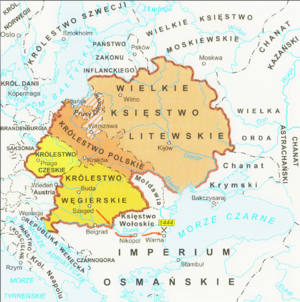
Grand Duchy of Lithuania Crown of the Kingdom of Poland
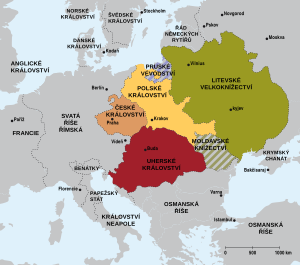
Grand Duchy of Lithuania
Contents
- Origin of the Jagiellonian Name
- Before the Jagiellonian Dynasty
- Jagiellonian Rule in Poland
- Jagiellonian Rule in Hungary and Bohemia
- Jagiellonian Grand Dukes of Lithuania
- Jagiellonian Kings of Poland
- Jagiellonian Kings of Bohemia, Hungary and Croatia
- Other Important Jagiellonians
- Family Tree of the Jagiellons
- Monarchs of Central Europe
- Legacy of the Jagiellons
- See also
Origin of the Jagiellonian Name
The name Jagiellonian comes from Jogaila. He was the first Grand Duke of Lithuania to become King of Poland. In Polish, the family is called Jagiellonowie.
The name Jogaila means "strong rider." It comes from Lithuanian words. These words are joti (to ride) and gailus (strong, powerful).
Before the Jagiellonian Dynasty
The previous ruling family in Poland was the Piasts. Their rule ended in 1370 with King Casimir III the Great. The Gediminids were the rulers of Lithuania before the Jagiellonians. They held the title of Grand Duke.
Jogaila, the first Jagiellonian ruler, was the Grand Duke of Lithuania. He converted to Christianity and married Queen Jadwiga of Poland. This marriage made him King of Poland. He became Władysław II Jagiełło and started the Jagiellonian dynasty.
Jagiellonian Rule in Poland
Władysław II Jagiełło and Władysław III
The Polish-Lithuanian Union
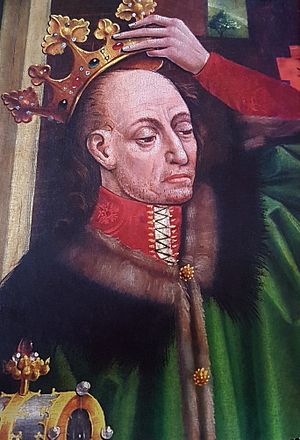
In 1385, the Union of Krewo was signed. It joined Queen Jadwiga of Poland and Jogaila. Lithuania was the last pagan state in Europe at that time. The Union led to Jogaila's baptism and their marriage.
This union made both nations stronger. They could better resist the Teutonic Knights. It also helped against the growing power of Moscow. This union was unique because it connected two states from different Christian traditions.
The goal was to create one common state under Władysław II Jagiełło. However, fully joining Lithuania into Poland was difficult. There were often disagreements and even wars between Poland and Lithuania. Sometimes, Lithuanians even worked with the Teutonic Knights against the Poles.
Battles with the Teutonic Knights
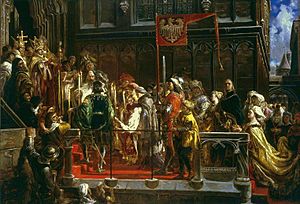
A major war, the Great War, happened from 1409 to 1411. It started because Lithuanians rebelled in a region controlled by the Teutonic Order. The most famous battle was the Battle of Grunwald. Here, Polish and Lithuanian armies completely defeated the Teutonic Knights.
However, they failed to capture the fortress of Malbork. This failure had long-term consequences for Poland. The Peace of Thorn in 1411 gave Poland and Lithuania only small land gains.
The Polish-Hungarian Union
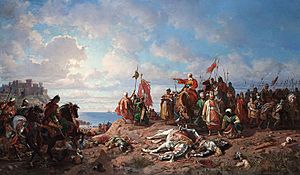
The Jagiellonian dynasty did not automatically inherit the throne. Each new king needed approval from the nobility. Władysław Jagiełło had two sons late in his life. In 1430, the nobility agreed that his son Władysław III would succeed him.
In 1434, Władysław Jagiełło died. His young son Władysław became king. The Royal Council, led by Bishop Oleśnicki, governed for him. In 1438, Czech groups offered the Czech crown to Jagiełło's younger son, Casimir IV. This led to two failed Polish military trips to Bohemia.
After the death of Vytautas in 1430, Lithuania faced internal wars. Casimir IV was sent to Lithuania in 1440. The Lithuanians surprisingly made him Grand Duke of Lithuania.
Bishop Oleśnicki wanted Poland to unite with Hungary. The Ottoman Empire was expanding and threatening Hungary. Hungary needed a strong ally like Poland-Lithuania. In 1440, Władysław III became the King of Hungary. He led the Hungarian army against the Ottomans in 1443 and 1444. Władysław III was killed in the Battle of Varna.
Casimir IV Jagiellon
In 1445, Casimir, the Grand Duke of Lithuania, was asked to become King of Poland. His brother Władysław had died. Casimir was a tough negotiator. He did not accept all the Polish nobility's demands for his election.
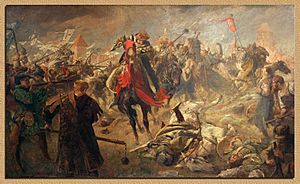
Casimir was the youngest son of King Władysław II Jagiełło. He had little formal education. He often relied on his instincts. He was very interested in diplomacy and the country's economy.
When the Grand Duke of Lithuania died, Lithuanian nobles supported Casimir. They invited him to Vilnius in 1440. He was proclaimed Grand Duke of Lithuania. Casimir became King of Poland in 1447. He married Elisabeth of Austria in 1454. This marriage strengthened ties between the Jagiellons and the rulers of Hungary-Bohemia.
The Thirteen Years' War (1454–1466)
In 1454, Casimir was asked for help by the Prussian Confederation. They wanted help against the Teutonic Order. Casimir promised to help. He made the Prussian regions a protectorate of Poland.
When cities rebelled against the Order, the Thirteen Years' War began. Casimir and the Prussian Confederation defeated the Teutonic Order. They captured its capital at Marienburg.
In the Second Peace of Thorn (1466), the Order accepted Polish rule over western Prussia. Poland gained back Pomerelia, which gave it important access to the Baltic Sea.
Wars with Turks and Tatars
The Jagiellonian dynasty's influence in Central Europe grew. In 1471, Casimir's son Władysław became King of Bohemia. In 1490, he also became King of Hungary.
The southern and eastern parts of Poland and Lithuania faced threats. The Turks began invading in the late 15th century. Crimean Tatars, supported by the Turks, raided eastern territories. King Jan Olbracht, Casimir's son, fought them.
More destructive Tatar raids happened in 1498-1500. Peace efforts followed, leading to a truce in 1503.
Sigismund I the Old and Sigismund II Augustus

Alexander became King of Poland in 1501. In 1506, Sigismund I the Old succeeded him in both Poland and Lithuania. This brought the two states even closer.
In 1518, Sigismund I married Bona Sforza, a strong Italian princess. Bona tried to make the king's power and finances stronger. She also worked to help her family's interests. This caused some unhappiness among the nobility.
The "Chicken War" Rebellion
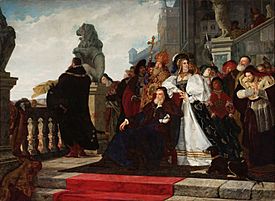
In 1537, a rebellion by the Polish nobility happened. It was called the Chicken War by those who supported the King. The nobles had gathered for a military campaign, but instead, they rebelled. They wanted the King to stop his reforms.
The nobles made 36 demands. They wanted Queen Bona to stop buying land. They also wanted more privileges for the nobility. They criticized Queen Bona for how she raised Prince Sigismund Augustus. They also felt she was trying to gain too much power.
Sigismund II Augustus

Sigismund II Augustus became Grand Duke of Lithuania at age 9 in 1529. He started ruling Lithuania independently in 1544. In 1547, he moved his royal court from Kraków to Vilnius. This greatly influenced the region's intellectual life. He also finished rebuilding the Palace of the Grand Dukes of Lithuania in Vilnius in a Renaissance style.
When Sigismund II became king, he faced opposition from the nobility. They were unhappy about his secret marriage to Barbara Radziwiłł. His mother, Bona, and many powerful nobles also opposed it. Sigismund II overcame this resistance. He had Barbara crowned queen in 1550. She died a few months later. Sigismund II walked with Barbara's funeral procession from Kraków to Vilnius.
Sigismund II was known for his patience and diplomatic skills. He understood the Polish parliament (sejm) very well. He managed to get more money from the sejm than his father. He also avoided major conflicts with the powerful Turks.
Sigismund II helped mediate between Catholics and Protestants for twenty years. The Livonian War was difficult for Lithuania. The Lithuanian nobility also wanted equal rights with the Polish nobility. These factors led to the Union of Lublin. This union joined Poland and Lithuania into the Polish–Lithuanian Commonwealth. This was a major achievement for Sigismund II.
The Golden Age of Polish Culture
The "Polish Golden Age" refers to the reigns of Sigismund I and Sigismund II. This period, especially the 16th century, saw the rise of the Polish Renaissance culture. This cultural growth was supported by wealthy nobles and city dwellers in places like Kraków and Gdańsk.
The Renaissance ideas came from Italy. This was partly due to Sigismund I's marriage to Bona Sforza. Many Poles traveled to Italy to study. Italian artists and thinkers also came to Poland. They settled and worked there for many years.
The Academy of Kraków and Sigismund II had large libraries. Smaller book collections became common in noble homes and schools. More people learned to read and write. By the end of the 16th century, most parishes had a school.
Jagiellons and the Habsburgs
In 1515, an agreement was made in Vienna. It was between Maximilian I and the Jagiellon brothers, Vladislaus II and Sigismund I. This agreement aimed to stop the Emperor from supporting Poland's enemies.
However, relations worsened after Charles V became Emperor in 1519. The Jagiellons' rivalry with the House of Habsburg in Central Europe ended with the Habsburgs gaining more power.
The expansion of the Ottoman Empire weakened the Jagiellonian monarchies. Hungary became very vulnerable after the Ottomans captured Belgrade in 1521. To stop Poland from helping Hungary, the Ottomans raided southeastern Poland-Lithuania in 1524.
The Hungarian army was defeated in 1526 at the Battle of Mohács. The young King Louis II Jagiellon was killed. Hungary was then divided between the Habsburgs and the Ottomans.
Jagiellonian Rule in Hungary and Bohemia
Vladislaus II of Hungary
King of Bohemia
Vladislaus was born in 1456. He was the oldest son of King Casimir IV Jagiellon of Poland. His mother was Elizabeth of Austria. He was named after his grandfather, King Władysław II Jagiełło.
He became King of Bohemia in 1471. He was only fifteen years old. His advisors greatly influenced him. The conflict over the Bohemian throne ended in 1479. Vladislaus ruled Bohemia, while another ruler gained other territories.
King of Hungary
Great disorder came to Hungary when King Matthias Corvinus died in 1490. The Hungarian nobles did not accept his son as king. They called Vladislaus to Hungary. His mother was related to a former Hungarian king.
Vladislaus became King of Hungary in 1490. He moved to Hungary and lived there for the rest of his life. His children were born in the palace of Buda. The Hungarian nobility held much power. Vladislaus became less involved in daily rule. He gained the nickname "Vladislaus Bene" because he often answered "Bene" (Latin for "It is well") to requests.
Louis II of Hungary

Louis II was the son of Vladislaus II. In 1515, he married Mary of Austria. His sister Anne married Ferdinand of Austria.
When Suleiman I became sultan, he sent an ambassador to Louis II. He wanted to collect the yearly tribute from Hungary. Louis refused and had the ambassador executed. Louis hoped other Christian states would help him. This event sped up Hungary's decline.
The Ottoman Empire declared war on Hungary. Louis failed to gather his forces. Hungary did not get help from other European states. Belgrade and other important castles were captured by the Ottomans. This left Hungary open to further Turkish conquests.
In 1526, Suleiman launched another expedition to conquer Hungary. Louis made a mistake by fighting the Ottoman army in an open field. His army was not ready for the battle. On August 29, 1526, Louis led his forces against Suleiman at the Battle of Mohács.
The Hungarian army was surrounded and suffered heavy losses. The twenty-year-old king died in a marsh during the retreat. Louis had no children. Ferdinand was elected as his successor in Bohemia and Hungary.
Jagiellonian Grand Dukes of Lithuania
| Portrait | Name | Born | Died | Reign | Spouse | Note |
|---|---|---|---|---|---|---|
 |
Władysław II Jagiełło | ca. 1362 | 1434 | 1377–1381, 1382–1434 | Jadwiga of Poland Anne of Cilli Elisabeth of Pilica Sophia of Halshany |
Founder of the Lithuanian Jagiellonian dynasty. He became King of Poland in 1386 after becoming Christian and marrying Queen Jadwiga. |
 |
Władysław III Jagiellon | 1424 | 1444 | 1434–1444 | none | Eldest son of Władysław II Jagiełło. |
 |
Casimir IV Jagiellon | 1427 | 1492 | 1440–1492 | Elisabeth of Austria | Became Grand Duke of Lithuania in 1440, then King of Poland in 1447. |
 |
Alexander I Jagiellon | 1461 | 1506 | 1492–1506 | Helena of Moscow | Became Grand Duke of Lithuania in 1492, then King of Poland in 1501. |
 |
Sigismund I the Old | 1467 | 1548 | 1506–1548 | Barbara Zápolya Bona Sforza |
Elected Grand Duke of Lithuania and Supreme Duke. |
 |
Sigismund II Augustus | 1520 | 1572 | 1544–1572 | Elisabeth of Austria Barbara Radziwiłł Catherine of Austria |
Became Grand Duke of Lithuania in 1544, then King of Poland in 1548. |
The Jagiellonians were the main heirs to the title of Grand Duke of Lithuania. They were the most powerful branch of the Gediminids dynasty.
Jagiellonian Kings of Poland
| Portrait | Name | Born | Died | Reign | Spouse |
|---|---|---|---|---|---|
 |
Władysław II Jagiełło | ca. 1362 | 1434 | 1386–1434 | Jadwiga of Poland Anne of Cilli Elisabeth of Pilica Sophia of Halshany |
 |
Władysław III of Poland | 1424 | 1444 | 1434–1444 Poland 1440–1444 Hungary |
none |
 |
Casimir IV Jagiellon | 1427 | 1492 | 1447–1492 | Elisabeth of Austria |
 |
John I Albert | 1459 | 1501 | 1492–1501 | none |
 |
Alexander I Jagiellon | 1461 | 1506 | 1501–1506 | Helena of Moscow |
 |
Sigismund I the Old | 1467 | 1548 | 1507–1548 | Barbara Zápolya Bona Sforza |
 |
Sigismund II Augustus | 1520 | 1572 | 1530/1548-1572 | Elisabeth of Austria Barbara Radziwiłł Catherine of Austria |
After Sigismund II Augustus, the Jagiellonian dynasty changed. His sisters, Anna Jagiellon and Catherine Jagiellon, were his heirs. Catherine married Duke John of Finland, who became King John III of Sweden. Their son, Sigismund III Vasa, led to the Jagiellonian line merging with the House of Vasa. This family ruled Poland from 1587 to 1668.
Jagiellonian Kings of Bohemia, Hungary and Croatia
The Jagiellonians also gained control of Bohemia and Hungary. Vladislaus Jagiello became King of Hungary in 1490. He moved his court to Hungary. His children were born and raised there.
When Louis II died suddenly in the Battle of Mohács in 1526, this royal line ended for male heirs.
| Portrait | Name | Born | Died | Reign | Spouse |
|---|---|---|---|---|---|
 |
Vladislaus II of Bohemia and Hungary | 1456 | 1516 | 1471–1516 Bohemia 1490–1516 Hungary and Croatia |
Barbara of Brandenburg Beatrice of Naples Anne of Foix-Candale |
 |
Louis II of Hungary and Bohemia | 1506 | 1526 | 1516–1526 Bohemia, Hungary, Croatia | Mary of Austria |
Other Important Jagiellonians
| Portrait | Name | Born | Died | Spouse | Offices and Titles |
|---|---|---|---|---|---|
 |
Hedwig Jagiellon of Poland | 1457 | 1502 | George, Duke of Bavaria | Duchess of Bavaria-Landshut |
 |
Saint Casimir | 1458 | 1484 | none | Saint of the Roman Catholic Church Patron saint of the Polish–Lithuanian Commonwealth |
 |
Sophia Jagiellon of Poland | 1464 | 1512 | Frederick I, Margrave of Brandenburg-Ansbach | Margravine of Brandenburg-Ansbach |
 |
Fryderyk Jagiellończyk | 1468 | 1503 | none | Archbishop of Gniezno Bishop of Kraków Primate of Poland |
 |
Anna Jagiellon of Poland | 1476 | 1503 | Bogislaw X, Duke of Pomerania | Duchess consort of Pomerania |
 |
Barbara Jagiellon of Poland | 1478 | 1534 | George, Duke of Saxony | Duchess consort of Saxony |
 |
Anne of Bohemia and Hungary | 1503 | 1547 | Ferdinand I, Holy Roman Emperor | Queen consort of the Romans Queen consort of Bohemia and Hungary |
 |
Hedwig Jagiellon of Poland | 1513 | 1573 | Joachim II Hector, Elector of Brandenburg | Electress consort of Brandenburg |
 |
Isabella Jagiellon of Poland | 1519 | 1559 | John Zápolya | Queen consort of Eastern Hungary |
 |
Sophia Jagiellon of Poland | 1522 | 1575 | Henry V, Duke of Brunswick-Lüneburg | Duchess consort of Brunswick-Lüneburg |
 |
Anna Jagiellon of Poland | 1523 | 1596 | Stephen Báthory | King of Poland Queen consort of Poland |
 |
Catherine Jagiellon of Poland | 1526 | 1583 | John III of Sweden | Queen consort of Sweden |
Family Tree of the Jagiellons
| Vladislaus II (Jogaila) c. 1351–1434 G. Duke of Lithuania, 1377–1401 King of Poland, 1386–1434 |
|||||||||||||||||||||||||||||||||||||||||||||||||||||||||||||||||||||||||||||||||||||||||||||||||||||||
| Elisabeth Bonifacia 1399 |
Hedwig 1408–1431 |
Vladislaus III 1424–1444 King of Poland, 1434–1444 King of Hungary, 1440–1444 |
Casimir 1426–1427 |
Casimir IV 1427–1492 G. Duke of Lithuania, 1440–1492 King of Poland, 1447–1492 |
|||||||||||||||||||||||||||||||||||||||||||||||||||||||||||||||||||||||||||||||||||||||||||||||||||
| Vladislaus II 1456–1516 King of Bohemia, 1471–1516 King of Hungary, 1490–1516 |
Hedwig 1457–1502 Duchess of Bavaria-Landshut, 1475–1502 |
Saint Casimir 1458–1484 |
John I Albert 1459–1501 King of Poland, 1492–1501 |
Alexander 1461–1506 G. Duke of Lithuania, 1492–1506 King of Poland, 1501–1506 |
Sophia 1464–1512 Margravine of Brandenburg-Ansbach, 1479–1512 |
Elisabeth 1465–1466 |
Sigismund I 1467–1548 King of Poland and G. Duke of Lithuania, 1506–1548 |
Frederick 1468–1503 Bishop of Kraków, 1488–1503 Archbishop of Gniezno, 1493–1503 |
Elisabeth 1472–after 1480 |
Anna 1476–1503 Duchess of Pomerania, 1491–1503 |
Barbara 1478–1534 Margravine of Meissen, 1494–1534 |
Elisabeth c. 1483–1517 Duchess of Liegnitz, 1515–1517 |
|||||||||||||||||||||||||||||||||||||||||||||||||||||||||||||||||||||||||||||||||||||||||||
| Anna 1503–1547 Queen of Hungary and Bohemia, 1526–1547 Queen of the Romans, 1531–1547 |
Louis II 1506–1526 King of Hungary and Bohemia, 1516–1526 |
Hedwig 1513–1573 Electress of Brandenburg, 1535–1573 |
Anna 1515–1520 |
Isabella 1519–1559 Queen of Hungary, 1539–1540 |
Sigismund II Augustus 1520–1571 King of Poland and G. Duke of Lithuania, 1548–1572 |
Sophia 1522–1575 Duchess of Brunswick- Wolfenbüttel, 1556–1568 |
Anna 1523–1596 Queen of Poland and G. Duchess of Lithuania, 1575–1586 |
Catherine 1526–1583 Duchess of Finland, 1562–1583 Queen of Sweden, 1569–1583 |
|||||||||||||||||||||||||||||||||||||||||||||||||||||||||||||||||||||||||||||||||||||||||||||||
Notes:
Monarchs of Central Europe
Other
Legacy of the Jagiellons
The Jagiellonian dynasty left a lasting impact. Many places and things are named after them:
- The Jagiellonian University in Kraków is one of the oldest universities in Europe.
- The Jagiellonian Library is part of the Jagiellonian University.
- The Globus Jagellonicus is thought to be one of the oldest globes showing the Americas.
- Jagiellonian tapestries are a famous collection of woven artworks.
- Jagiellonia Białystok is a football club in Poland.
- The Jagiełło Oak is a very old and noted tree in the Białowieża Forest.
See also
 In Spanish: Dinastía Jagellón para niños
In Spanish: Dinastía Jagellón para niños
- History of Poland during the Jagiellon dynasty
- List of Polish rulers
- List of Czech rulers
- List of Hungarian rulers
- List of Lithuanian rulers


